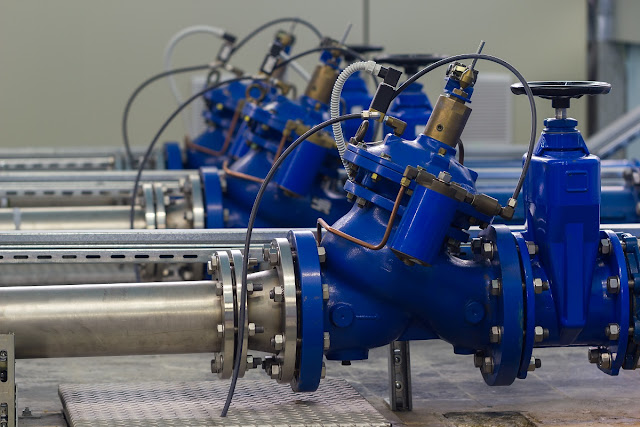Flow control valve is used to control the pressure and flow rate of liquids or gases through a pipeline. Hydraulic flow control valve operates and throttles to maintain a preset flow rate or/and limit the maximum flow rate irrespective of changing upstream and downstream pressures. Flow control valves are necessary for optimising system performance, depending on a flow port or passage with a variable flow area.
Here’s a look at the following function of hydraulic flow control valves, the various components and types and working principle including some relevant considerations in choosing the appropriate hydraulic flow control valve for a specific application.
Hydraulic Flow Control Valves
Flow control valves can also function with hydraulic actuators. These are also known as Automatic Control Valves. The hydraulic actuators will respond to changes in flow or pressure and allow open or close the valve. The fluid pressure is fair enough to open and close the Automatic Control Valves thus there’s no requirement of an external power source. Some Automatic Control Valves are flow control valves, back-pressure sustaining valves, pressure reducing valves, altitude valves and relief valves.Main Formula of Hydraulic Flow Control Valves
The fundamental objective of Flow Control Valve is to regulate the pressure of flow rate of fluid in a specific portion of hydraulic systems. They are designed to fit for hydraulic circuits and complex pneumatic. In hydraulic systems, flow control valves regulate the speed of the components by using to control the flow rate of cylinders and motors.
Hydraulic flow control valves also control the rate of energy transfer at a specific given pressure. The formula is based on the concept of physics calculating the work, energy and power.
Actuator force x travelling distance = work done on load
The energy transfer has to be equal to the total work done because the actuator speed dictates the rate of energy transfer.
Hydraulic Flow Control Valves Working Process
There are so many different types of flow control valves available, designed with most intended for specific applications. Therefore, understanding the working process of hydraulic flow control valves is essential in choosing the right plug for an application. The most familiar types of flow control valves are following-
- Ball
- Butterfly
- Diaphragm
- Needle
- Plug
The simplest flow control valves have an aperture which helps to open or close to increase or slow down the flow rate. Ball valves are amongst the simplest options, consisting of a ball attached to a handle. The ball has a hole along the centre, and when the handle is turned up, the gap is aligned with valve openings to allow flow. On the other hand, shut off the flow, the handle is used to turn the hole perpendicular to the valve openings, which halts the flow.
Other types of valve work in a similar fashion with some mechanism for either to allow or block the flow. Needle valves are among the more precise valve options having an adjustable needle and a valve stem which prevent or permits the flow of liquid. A butterfly valve has an internal metal plate connected to a turning mechanism. The plate opens or closes according to the arrangement.
When it comes to the point of hydraulic circuits, there are numerous options for controlling flow. An engineering supply service provider like Metaval offers the range from the simplest to the sophisticated. These options are-
- Flow Regulators
- Bypass Flow Regulators
- Pressure-Compensated, Variable Flow Valves
- Pressure and Temperature Compensated, Variable Flow Valves
- Orifices
- Deceleration Valves
- Proportional Flow-Control Valves
- Flow Dividers etc.
Properties of a Flow Control Valve
Environmentally Friendly
Many industries are nowadays facing the pressure of maintaining the ecological standards. The valves earlier mentioned may become ecologically friendly by decreasing the wastes of natural resources and utilising them.
Reducing Working Pressure
It permits the operator to depressurise the solution hose quickly. By turn it off and open the flow control valves can release the back pressure.
Clog No More
The flow control valves do not prevent the fluid flow. The perfect models of the valves do not permit deposits, dust and small particles to clog the flow of fluid.
Saves Money and Water
Flow Control Valves are beneficial to faucets, helps a lot in conservation. It helps to prevail in spending too much on water bills and wasting resources. The faucets can preserve up to almost 85% of the water used. This means low demand for water supply during dry seasons including the low water bills to pay.
Reliability and Performance
These valves are even used in various applications such as food processing machines, material handling equipment and conveyors.Challenges & Design Considerations for Hydraulic Flow Control Valves
These valves provide a cost-effective solution regarding the flow rate. But they are not excluding their problem, leading to a loss of pressure while valves are partially halted, which has an impact on overall performance. Considering more basic flow control valves changes is flow rate can occur even when the control valve is in a static position, because of the system pressure, temperature or other variables, heading to reliability concerns.
Usually Flow Control Valve control actuators in a hydraulic system. For the control valve, other factors influence the rate of flow, including temperature, pump output and other issues. Designing the proper valve for an application needs careful considerations of the various factors that can impact performance, flow and durability such as – maximum and minimum flow rate, fluid density, maximum noise tolerance, allowable leakage limit while the valve is in a closed position etc.


Comments
Post a Comment